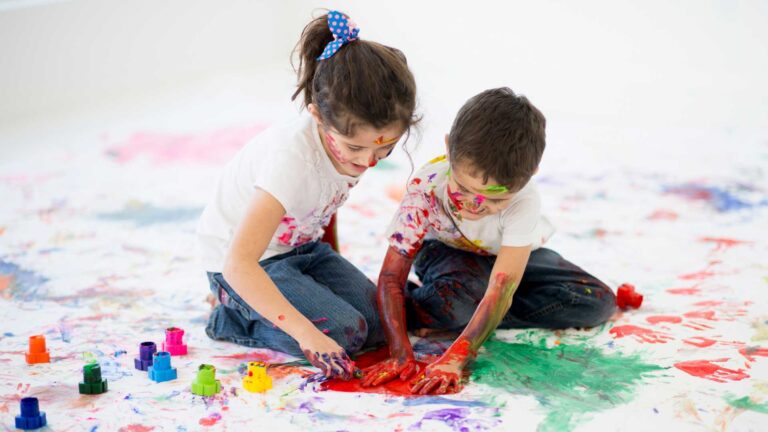Throughout history, art has served as a powerful form of expression and has provided numerous benefits to those who engage in it, including relaxation, learning, and the development of creativity. Due to its diverse advantages, many professionals recommend incorporating artistic activities into the development of children, including neurodivergent kids.
The use of art in a therapeutic setting is known as ‘art therapy,’ a valuable tool for fostering expression in children with autism spectrum disorder (ASD). Autism art therapy is incorporated into the treatment plans of children on the spectrum, helping to enhance their behavior and expression while providing a sense of calm and serenity. The goal of autism art therapy is to offer neurodivergent children an alternative and potent means of communication and coping with the challenges that life with autism can present.
At ABA Centers of America, we support and encourage the interests of each client. As such, we allow children who participate in our ABA therapies and have a passion for art to join art therapy sessions to experience its benefits while having fun and learning. This blog will explore the intersection of art therapy and autism, discussing what autism art therapy entails and its advantages.
What Exactly Does Autism Art Therapy Entail?
Art therapy is a form of psychotherapy that utilizes art as a means of expression and communication to tackle emotional issues that may be challenging to articulate. Art therapy nurtures mental and emotional growth and seeks to impart life skills that encourage independence and collaboration while fostering self-expression, processing, and creativity.
Autism art therapy equips children with a tool to address emotional conflicts in a manner that fosters a sense of safety and tranquility.
How Does Art Therapy Work in Autism?
Autism is a developmental disorder in which neural connections occur differently than in neurotypical individuals, causing difficulties in developing the skills necessary for social interactions and behavior. While there is no cure for autism, there are alternatives to help neurodivergent individuals learn and enhance the skills and behaviors contributing to a better quality of life, such as ABA therapy.
Art therapy can complement ABA therapy by effectively facilitating the expression of experiences among individuals with autism in an enjoyable, fun, and relaxed manner. People with autism often process visual information more effectively than verbal information, making art a highly beneficial tool due to its sensory nature.
The expression and creativity involved in art can serve as a vital tool for children with autism spectrum disorder, enabling them to externalize their emotions and cope uniquely with life. Furthermore, art therapy profoundly impacts cognition, addresses spatial and visual disparities, fosters coping mechanisms, and develops fine motor skills.
What Are the Benefits of Art Therapy for ASD?
Art therapy can enhance communication and social relationships, improve eye contact, understand cause and effect, present abstract concepts, and enhance dynamic memory. Furthermore, art provides a platform to explore the unique abilities of each child with autism. To delve deeper into the benefits of art therapy for ASD, let’s examine each aspect:
Sensory Stimulation:
As mentioned earlier, engaging in art provides a visual and tangible sensory experience. Children with autism often have heightened sensitivity to stimuli, making this activity a source of comfort and relaxation where they can feel secure. Art therapy activities may include sculpting with putty, finger painting, using brushes to paint, paper folding, or crumpling.
Social Skills Development:
Art therapy typically occurs in settings with other children and teachers, allowing your child to interact with peers and adults. Participating in art classes also encourages practicing critical social skills, including listening and communication with teachers, peers, and therapists.
Art therapy for autism stimulates a part of the brain that enables non-verbal expression through painting, drawing symbols, and creating icons.
An Alternative Form of Expression:
Some children with autism are non-verbal or have a minimal vocabulary. In such cases, art therapy offers an effective alternative for expression while further developing their skills. The outcomes of art therapy are also precious for parents, as it provides an opportunity to witness a visual presentation of their child’s inner self, fostering a deeper understanding.
Strengthens Bonds:
As mentioned earlier, art therapy can enhance the connection between parents and their children. Through the art projects of children with autism, parents gain a deeper understanding of their child’s perspective on the world. Moreover, when parents acknowledge and celebrate their children’s creations, such as displaying their art at home, it fosters a sense of value and strengthens their bond. Additionally, sharing and participating in activities your child enjoys can be a fantastic way to spend quality time together.
Motor Skills Development:
Artistic activities, like sculpting, painting, drawing, or grinding, demand fine motor skills. Engaging in these activities contributes to the motor development of children with autism, fostering skills that will support them throughout their lives and promote independence.
Encourages Expression of Feelings:
Many neurodivergent children struggle with emotional stability, anxiety, and stress due to their condition challenges. Through autism art therapy, children can learn to express their emotions and better manage them by creating something new. Additionally, hands-on activities such as drawing and collage-making help develop patience and problem-solving skills.
Improved Self-Awareness and Self-Esteem:
During autism art therapy sessions, neurodivergent individuals often experience a sense of excitement and accomplishment when they complete an art project. For many, creating something from scratch and seeing it through to completion boosts self-esteem, expands their knowledge, and develops new skills.
Art therapy also allows neurodivergent individuals to explore their tastes and preferences while engaging in enjoyable activities; this fosters a sense of independence, autonomy, and courage, which is crucial for individuals on the spectrum.
Nervous System Relaxation:
Providing tools to teach children with autism how to regulate their nervous systems is crucial for their emotional and behavioral development. That’s why multisensory experiences offer many benefits for helping neurodivergent children explore their emotions through listening, touching, and seeing.
In addition to enhancing communication skills and sensory sensitivity, autism art therapy aids in regulating the nervous system. Therapists can stimulate the sense of touch using kinetic sand, playdough, and paint, which help in relaxation and nervous system regulation.
ABA Centers of America and Autism Art Therapy
At ABA Centers of America, we provide support and services to the autism community, including diagnosis, ABA therapy for children and adolescents, and early intervention. We also actively encourage children on the spectrum to pursue their interests and passions to help them realize their dreams.
If your child is interested in art activities, don’t hesitate to ask their therapy team to include them in art therapy sessions. This activity can significantly enhance your child’s quality of life. Our ABA therapies at ABA Centers of America always incorporate your child’s interests and motivations into the sessions to create an enjoyable and educational environment.
For more information about our services and ABA therapy, please contact us at (844) 923 4222 or visit our website and fill out the contact form.







